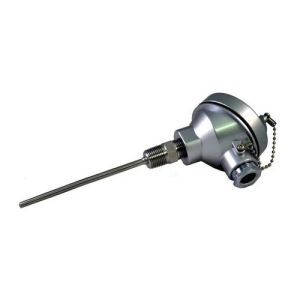Thermocouple:
Thermocouple, a sensor that is used for measuring temperature. This design of the sensor consists of two dissimilar metal wires which are joined together at one end, connected to an instrument that can accept a thermocouple input and measure the reading.
They sense the temperature, and the temperature is further measured by other instruments after sensing it. As they convert a non-electrical quantity (temperature) into voltage (electrical quantity) so they are transducers also. Since the do not require any external power source to operate, so they are active transducers.
The conventional thermocouple is used with an outer protecting tube or thermowell to protect it from aggressive and corrosive process conditions.
The thermocouple working principle is based on the Seeback Effect. This effect states that when a closed circuit is formed by jointing two dissimilar metals at two junctions, and junctions are maintained at different temperatures then an electromotive force (e.m.f.) is induced in this closed circuit. The amount of induced e.m.f. is different for different metal combinations and is proportional to the temperature difference of the junctions. This is the basic thermocouple working principle.
The different types of thermocouples are T – Type Thermocouple, E – Type Thermocouple,
J – Type Thermocouple, K — Type Thermocouple, and S – Type Thermocouple.
Advantages:
- They follow the temperature changes with a small time-lag. So, it can be used in applications where very rapid changes in temperature take place. It responds to those changes very quickly.
- These are very convenient for measuring the temperature at one point in any apparatus or setup.
Resistance Temperature Detector (RTD):
A Resistance Temperature Detector (also known as RTD) is an electronic device used to determine the temperature by measuring the resistance of an electrical wire. This wire is referred to as a temperature sensor. If we want to measure temperature with high accuracy, an RTD is the ideal solution, as it has good linear characteristics over a wide range of temperatures.
Advantages:
- High accuracy
- Low drift
- Wide operating range
- Suitability for precision applications.
RTDs vs Thermocouples
The two most common ways of measuring temperatures for industrial applications are with resistance temperature detectors (RTDs) and thermocouples. The choice between them is typically determined by four factors;
Temperature
If process temperatures are between −200 and 500 °C (−328.0 and 932.0 °F), an industrial RTD is the preferred option. Thermocouples have a range of −180 to 2,320 °C (−292.0 to 4,208.0 °F),[9] so for temperatures above 500 °C (932 °F) it is the contact temperature measurement device commonly found in physics laboratories.
Response time
If the process requires a very fast response to temperature changes (fractions of a second as opposed to seconds), then a thermocouple is the best choice. Time response is measured by immersing the sensor in water moving at 1 m/s (3.3 ft/s) with a 63.2% step change.
Size
A standard RTD sheath is 3.175 to 6.35 mm (0.1250 to 0.2500 in) in diameter; sheath diameters for thermocouples can be less than 1.6 mm (0.063 in).
Accuracy and stability requirements
If a tolerance of 2 °C is acceptable and the highest level of repeatability is not required, a thermocouple will serve. RTDs are capable of higher accuracy and can maintain stability for many years, while thermocouples can drift within the first few hours of use.

